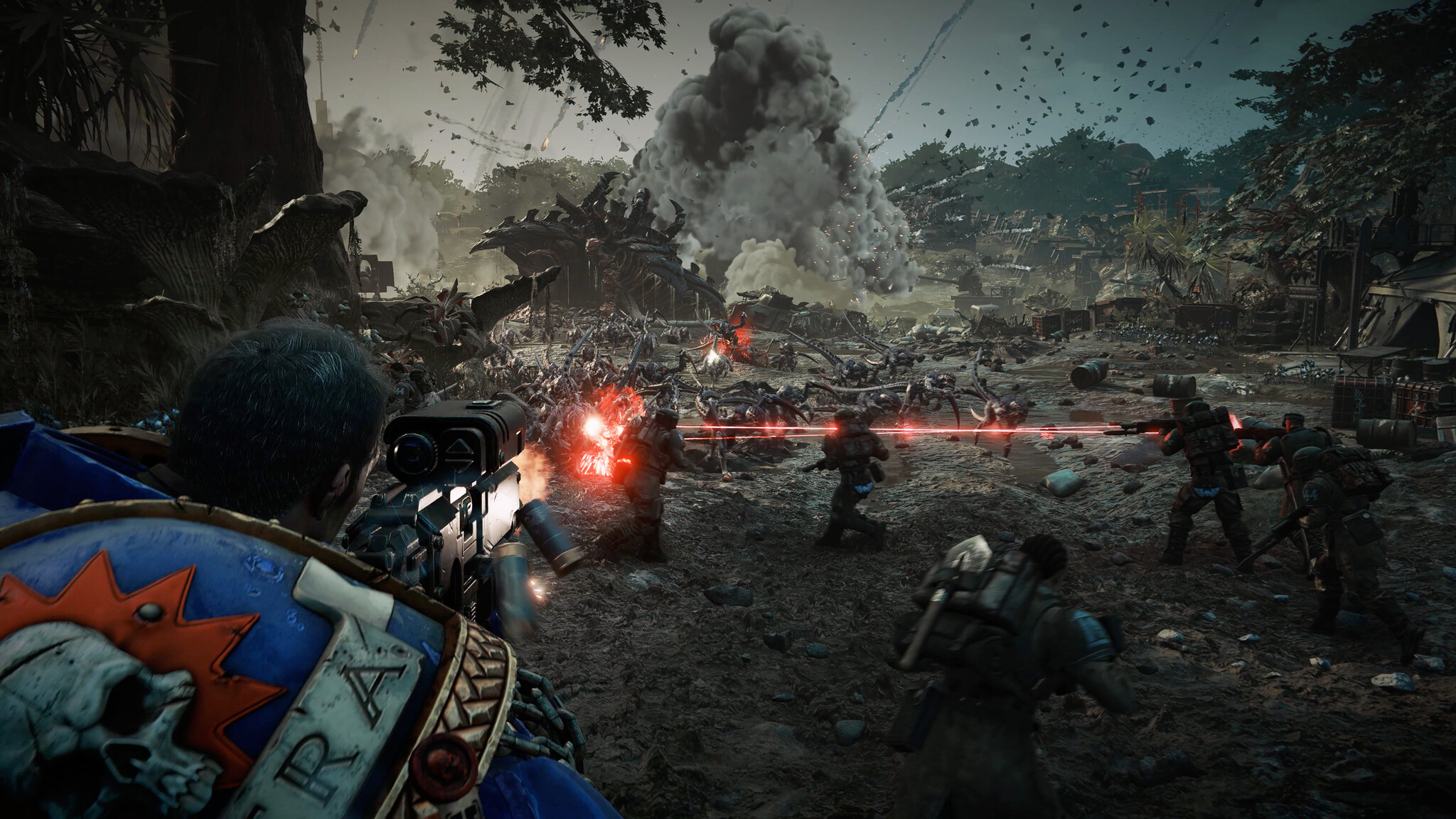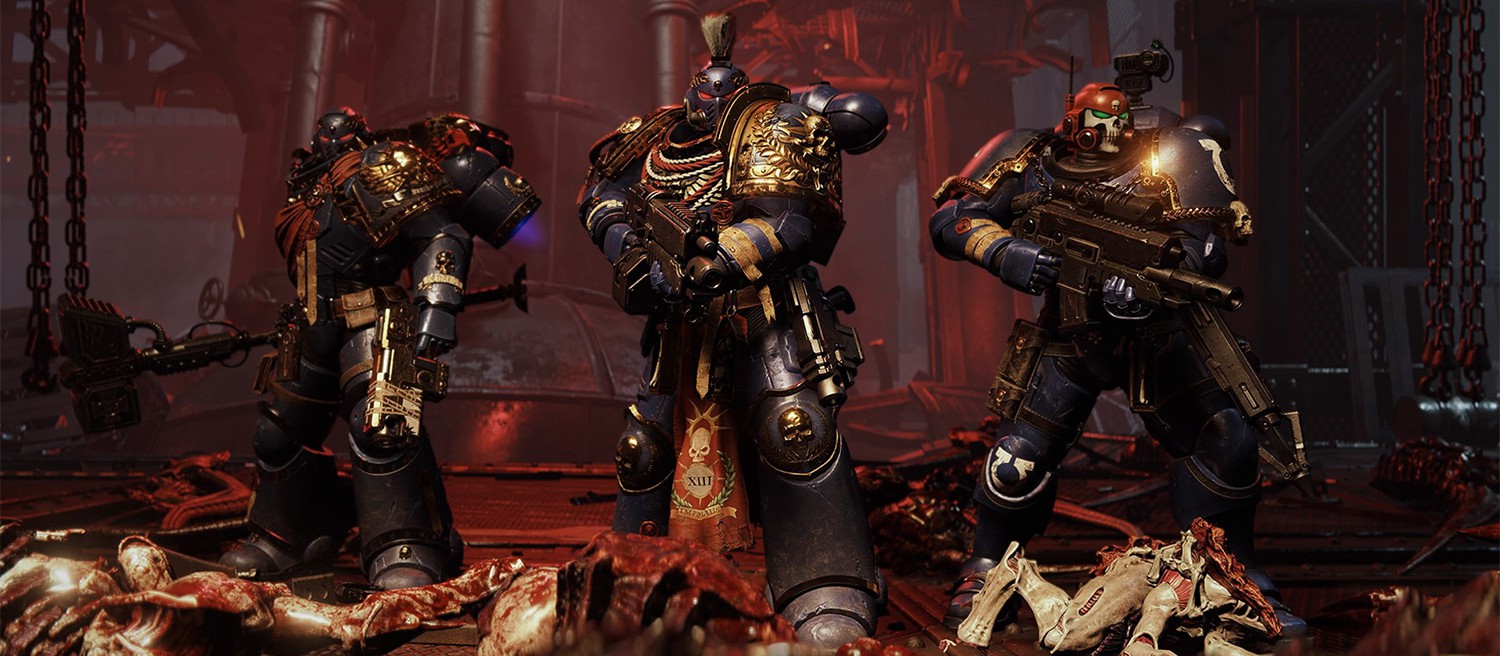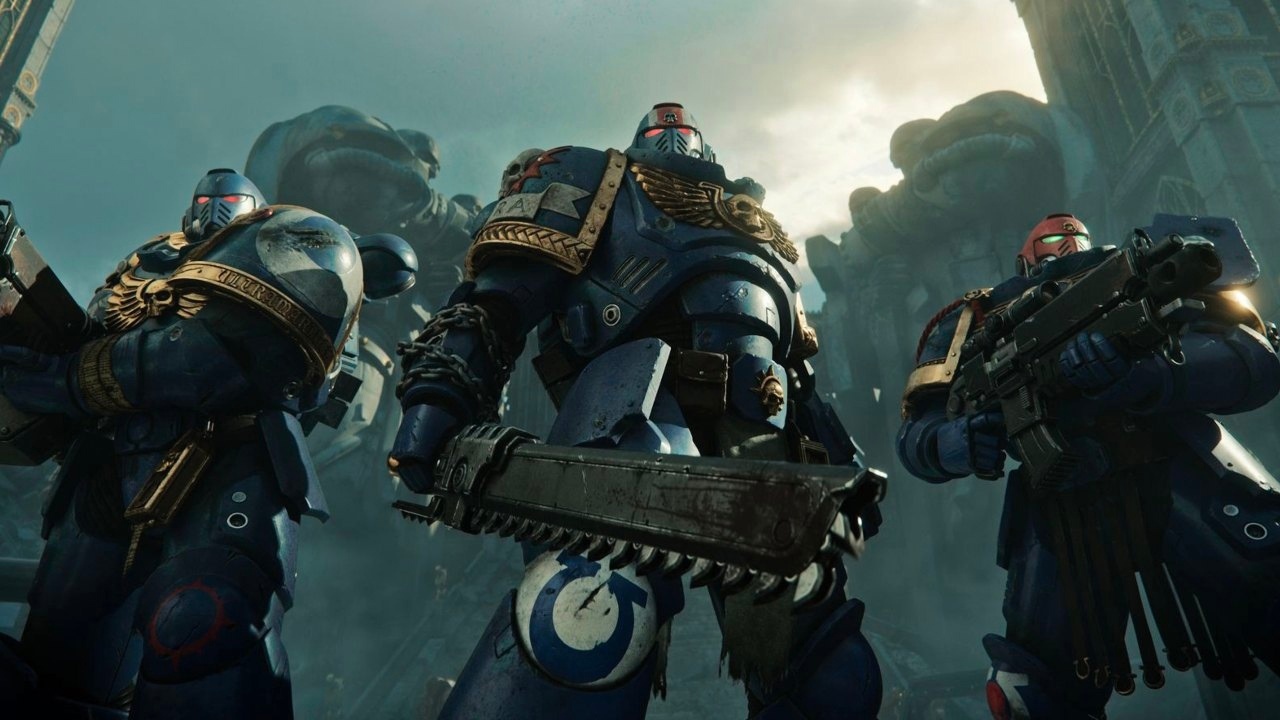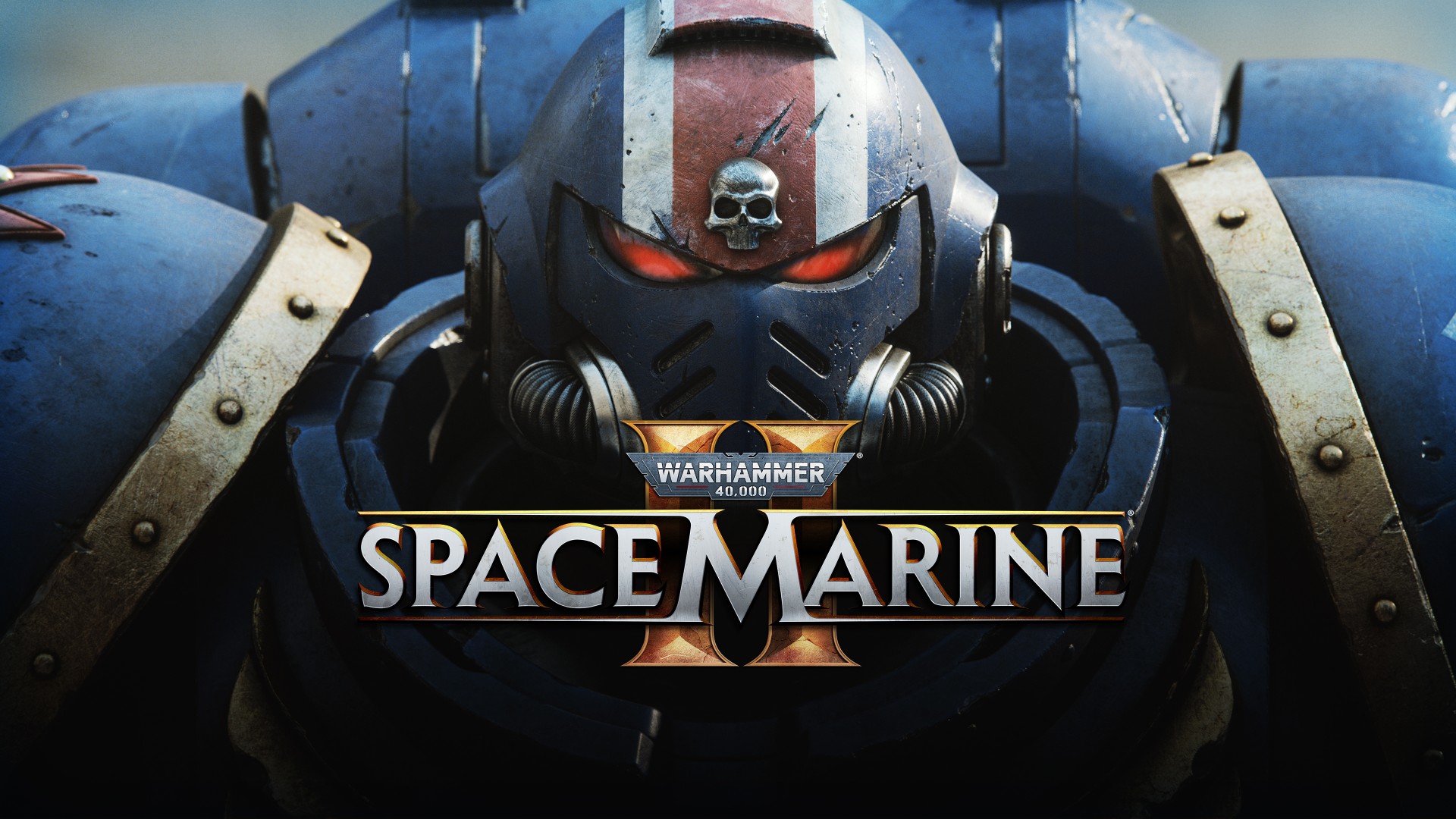
For your first couple of hours of fights, it looks and feels awesome, but unfortunately it's not long before cracks start to show. The biggest problem is those executions which at first feel so cool. Other than the swarming minions, every enemy will enter that stunned state once they're at low enough health, and because executions are one of your only ways to mitigate damage, it's always to your advantage to perform them. The result is that you're constantly sprinting between flashing red foes to watch the same canned animations over and over, a problem that only escalates as the game sends increasing numbers of elite troops at you in its later stages.
Your two AI companions—fellow Space Marines Gadriel and Chairon—will even stun enemies for you and politely leave them for you to finish off while foes around you stand awkwardly waiting for their turn. At first I found the absurdity funny, but even that wore thin before long.The whole system of combat is warped around this one mechanic. For example, because executions have to be performed at melee range, and are so vital for staying alive, long-range combat is largely pointless, despite the array of scoped weapons that cater for it. But equally the various close-range guns have little use either, because at that range you might as well just draw your melee weapon, and their lack of versatility will leave you caught out against certain enemy types. The sensible choice is always just your standard, mid-range boltgun. That's thematically appropriate, perhaps, but not ideal in a game that already struggles to offer variety in its repetitive combat encounters that far too often simply see you fighting the same small number of enemy types over and over.
Beyond that, fights simply feel rough around the edges. Parries are oddly inconsistent—some attacks come with a huge, flashing indicator and a giant timing window, while others aren't telegraphed at all and are easily missed in the crush. Against some attacks, parries will automatically kill or stagger the foe, but for others they don't—instead, you want to try and parry or dodge with perfect timing (a window that itself feels inconsistent) in order to be able to perform a bolt pistol counter-shot and recover some shield. But then sometimes simply a charged melee attack will get you that counter-shot instead. None of it quite clicks together.
The whole combat system is simply messy in this way—it feels like the developer iterated on it several times but forgot to go back and delete their old work, so multiple clashing ideas sit jumbled together. There are individual elements that work well—Titus feels huge without being slow or unresponsive, iconic Warhammer 40,000 weapons such as the thunder hammer are as impactful and empowering as they should be, and there's a great gory sense of humour to the animations. But it doesn't add up to a coherent vision, and over the course of the campaign the charm of the parts that do work is tarnished more and more by the repetition and frustration of the ones that don't.In some ways, the campaign is refreshingly focused—with no levelling system, unlocks, or side missions, and only a tiny smattering of collectibles, it's an antidote to the cluttered and bloated worlds of modern action games. For the most part it's just you and the combat setpieces, and when the game's firing on all cylinders, especially early on, that works. There's a real ambition and imagination to its spectacle, and the short campaign is full of sights to delight Warhammer 40,000 fans in particular.But again it's undermined by what you're actually doing. Much of the encounter design feels overly inspired by the game's co-op mode (more on that later)—you're constantly standing in a circle until a bar fills up, or defending a big inanimate object, or running between computer consoles pressing buttons, while arbitrary waves of enemies spawn at you. (You even have to wait for your two allies to "assemble" with you at the end of every area before you can push a button to move into the next one.)There's a mid-game sequence, for example, where an enormous swarm of tyranids attempt to hurl themselves bodily into a colossal power generator to try and destablise it. It's a wonderful visual—that perfect Warhammer mix of cool, scary, and completely absurd—but it's essentially a cross between wave-based survival and an escort mission, and the actual process of trying to keep the generator's health from ticking down while countless creatures much smaller and faster than you sprint at it is more tedious than epic.What does shine through is how passionate and knowledgeable about this setting Saber Interactive is. Though the story is fairly thin (essentially Titus is just in the middle of a big war trying to prevent the use of a dangerous macguffin) it nails both the broad strokes of how Warhammer 40,000 should feel, and its quieter, more nuanced elements.More often than not, videogames in this setting simply tell stories of heroic Imperials fighting against the forces of pure evil. So it was a pleasant surprise to see this game incorporate themes such as the simmering tension between the space marines and the Adeptus Mechanicus, a divergent cult needed for their engineering prowess but with their own inscrutable ambitions. Or the low-level internal politics within Titus' chapter, around questions of faith, corruption, and his own murky past. Or the strange layers of superstition and ignorance that hamper the Imperium's relationship with its own technology—there's something both poignant and funny about such powerful warriors having to follow awkward automated bureaucratic processes to get a machine started in the middle of a warzone, or offer some burnt incense and a prayer before accessing classified computer files.In some ways it's authentic to a fault, even—it's likely to be too in-depth for those unfamiliar with the universe, or even just more casual Warhammer fans. The game spends almost no time on exposition about the setting, trusting players to have done their homework, and it doesn't shy away from more obscure or complex reference points. If you don't know how the Deathwatch works and why being a Blackshield in it would be shameful, or the function of a Neurothrope in the synaptic network of the Tyranids, or the reason that a soldier of the Thousand Sons would have no corporeal body inside their armour… then you're likely to find yourself confused not just by the details of the plot but by what you see in fights, too.For those who are dedicated Warhammer 40,000 aficionados, however, there's a real thrill in such a major game not only representing the setting so well but refusing to compromise on it for a mainstream audience. Space Marine 2 revels in the specifics of Games Workshop's universe in a way I think very few games ever have, and that's something the community is sure to take to heart even if the overall experience is flawed.But while that atmosphere and authenticity never breaks, like the combat the story increasingly loses its way as the game goes on. It has an odd structure—by the end of the second act, any intrigue and mystery in the plot has been fully resolved already, and the character arcs of your companions have concluded. (Titus himself doesn't have an arc—he's just always right, and spends the game stoically waiting for everyone else to realise.) That leaves the third act with nothing to do but try and escalate all the fighting and shouting and apocalyptic threats ever higher and higher, and though the visuals are mostly impressive enough to back it up, it does all start to feel like so much noise.
Your two AI companions—fellow Space Marines Gadriel and Chairon—will even stun enemies for you and politely leave them for you to finish off while foes around you stand awkwardly waiting for their turn. At first I found the absurdity funny, but even that wore thin before long.The whole system of combat is warped around this one mechanic. For example, because executions have to be performed at melee range, and are so vital for staying alive, long-range combat is largely pointless, despite the array of scoped weapons that cater for it. But equally the various close-range guns have little use either, because at that range you might as well just draw your melee weapon, and their lack of versatility will leave you caught out against certain enemy types. The sensible choice is always just your standard, mid-range boltgun. That's thematically appropriate, perhaps, but not ideal in a game that already struggles to offer variety in its repetitive combat encounters that far too often simply see you fighting the same small number of enemy types over and over.
Beyond that, fights simply feel rough around the edges. Parries are oddly inconsistent—some attacks come with a huge, flashing indicator and a giant timing window, while others aren't telegraphed at all and are easily missed in the crush. Against some attacks, parries will automatically kill or stagger the foe, but for others they don't—instead, you want to try and parry or dodge with perfect timing (a window that itself feels inconsistent) in order to be able to perform a bolt pistol counter-shot and recover some shield. But then sometimes simply a charged melee attack will get you that counter-shot instead. None of it quite clicks together.
The whole combat system is simply messy in this way—it feels like the developer iterated on it several times but forgot to go back and delete their old work, so multiple clashing ideas sit jumbled together. There are individual elements that work well—Titus feels huge without being slow or unresponsive, iconic Warhammer 40,000 weapons such as the thunder hammer are as impactful and empowering as they should be, and there's a great gory sense of humour to the animations. But it doesn't add up to a coherent vision, and over the course of the campaign the charm of the parts that do work is tarnished more and more by the repetition and frustration of the ones that don't.In some ways, the campaign is refreshingly focused—with no levelling system, unlocks, or side missions, and only a tiny smattering of collectibles, it's an antidote to the cluttered and bloated worlds of modern action games. For the most part it's just you and the combat setpieces, and when the game's firing on all cylinders, especially early on, that works. There's a real ambition and imagination to its spectacle, and the short campaign is full of sights to delight Warhammer 40,000 fans in particular.But again it's undermined by what you're actually doing. Much of the encounter design feels overly inspired by the game's co-op mode (more on that later)—you're constantly standing in a circle until a bar fills up, or defending a big inanimate object, or running between computer consoles pressing buttons, while arbitrary waves of enemies spawn at you. (You even have to wait for your two allies to "assemble" with you at the end of every area before you can push a button to move into the next one.)There's a mid-game sequence, for example, where an enormous swarm of tyranids attempt to hurl themselves bodily into a colossal power generator to try and destablise it. It's a wonderful visual—that perfect Warhammer mix of cool, scary, and completely absurd—but it's essentially a cross between wave-based survival and an escort mission, and the actual process of trying to keep the generator's health from ticking down while countless creatures much smaller and faster than you sprint at it is more tedious than epic.What does shine through is how passionate and knowledgeable about this setting Saber Interactive is. Though the story is fairly thin (essentially Titus is just in the middle of a big war trying to prevent the use of a dangerous macguffin) it nails both the broad strokes of how Warhammer 40,000 should feel, and its quieter, more nuanced elements.More often than not, videogames in this setting simply tell stories of heroic Imperials fighting against the forces of pure evil. So it was a pleasant surprise to see this game incorporate themes such as the simmering tension between the space marines and the Adeptus Mechanicus, a divergent cult needed for their engineering prowess but with their own inscrutable ambitions. Or the low-level internal politics within Titus' chapter, around questions of faith, corruption, and his own murky past. Or the strange layers of superstition and ignorance that hamper the Imperium's relationship with its own technology—there's something both poignant and funny about such powerful warriors having to follow awkward automated bureaucratic processes to get a machine started in the middle of a warzone, or offer some burnt incense and a prayer before accessing classified computer files.In some ways it's authentic to a fault, even—it's likely to be too in-depth for those unfamiliar with the universe, or even just more casual Warhammer fans. The game spends almost no time on exposition about the setting, trusting players to have done their homework, and it doesn't shy away from more obscure or complex reference points. If you don't know how the Deathwatch works and why being a Blackshield in it would be shameful, or the function of a Neurothrope in the synaptic network of the Tyranids, or the reason that a soldier of the Thousand Sons would have no corporeal body inside their armour… then you're likely to find yourself confused not just by the details of the plot but by what you see in fights, too.For those who are dedicated Warhammer 40,000 aficionados, however, there's a real thrill in such a major game not only representing the setting so well but refusing to compromise on it for a mainstream audience. Space Marine 2 revels in the specifics of Games Workshop's universe in a way I think very few games ever have, and that's something the community is sure to take to heart even if the overall experience is flawed.But while that atmosphere and authenticity never breaks, like the combat the story increasingly loses its way as the game goes on. It has an odd structure—by the end of the second act, any intrigue and mystery in the plot has been fully resolved already, and the character arcs of your companions have concluded. (Titus himself doesn't have an arc—he's just always right, and spends the game stoically waiting for everyone else to realise.) That leaves the third act with nothing to do but try and escalate all the fighting and shouting and apocalyptic threats ever higher and higher, and though the visuals are mostly impressive enough to back it up, it does all start to feel like so much noise.



